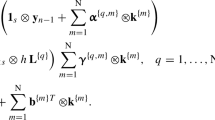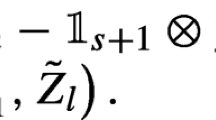Abstract
To integrate large systems of locally coupled ordinary differential equations with disparate timescales, we present a multirate method with error control that is based on the Cash–Karp Runge–Kutta formula. The order of multirate methods often depends on interpolating certain solution components with a polynomial of sufficiently high degree. By using cubic interpolants and analyzing the method applied to a simple test equation, we show that our method is fourth order linearly accurate overall. Furthermore, the size of the region of absolute stability is increased when taking many “micro-steps” within a “macro-step.” Finally, we demonstrate our method on three simple test problems to confirm fourth order convergence.







Similar content being viewed by others
Notes
We use the word “interpolation” to describe a method to construct a smooth approximation to the numerical solution between two times \(t_n\) and \(t_{n+1}\). However, the function that we derive does not pass through the numerical solution at \(t_{n+1}\). Strictly speaking, it is not an interpolant. Nevertheless, we still refer to these approximating functions as “interpolants.”
References
Andrus, J.F.: Numerical solution of systems of ordinary differential equations separated into subsystems. SIAM J. Numer. Anal. 16, 605–611 (1979)
Bartel, A., Günther, M.: A multirate W-method for electrical networks in state-space formulation. J. Comput. Appl. Math. 147(2), 411–425 (2002)
Bartel, A., Günther, M., Kvaerno, A.: Multirate methods in electrical circuit simulation. Prog. Ind. Math. ECMI 2000, 258–265 (2000)
Constantinescu, E.M., Sandu, A.: Extrapolated multirate methods for differential equations with multiple time scales. J. Sci. Comput. 56(1), 28–44 (2013)
Constantinescu, E.M., Adrian, Sandu: Multirate timestepping methods for hyperbolic conservation laws. J. Sci. Comput. 33, 239–278 (2007)
Constantinescu, E.M., Sandu, Adrian: Multirate explicit Adams methods for time integration. J. Sci. Comput. 38, 229–249 (2009)
Enright, W.H., Jackson, K.R., Nørsett, S.P., Thomsen, P.G.: Interpolants for Runge–Kutta formulas. ACM Trans. Math. Softw. 12(3), 193–218 (1986)
Gear, C.W., Wells, D.R.: Multirate linear multistep methods. BIT 24, 484–502 (1984)
Günther, M., Kværnø, A., Rentrop, P.: Multirate partitioned Runge–Kutta methods. BIT 41(3), 504–514 (2001)
Hairer, E., Norsett, S.P., Wanner, G.: Solving Ordinary Differential Equations I: Nonstiff Problems. Springer Series in Computational Mathematics. Springer (1987)
Horn, M.K.: Fourth and fifth order, scaled Runge–Kutta algorithms for treating dense output. SIAM J. Numer. Anal. 20(3), 558–568 (1983)
Hundsdorfer, W., Savcenco, V.: Analysis of a multirate theta-method for stiff ODEs. Appl. Numer. Math. 59, 693–706 (2009)
Kato, T., Kataoka, T.: Circuit analysis by a new multirate method. Electr. Eng. Jpn. 126(4), 1623–1628 (1999)
Logg, A.: Multi-adaptive time integration. Appl. Numer. Math. 48, 339–354 (2004)
Makino, J., Aarseth, S.: On a Hermite integrator with Ahmad-Cohen scheme for gravitational many-body problems. Publ. Astron. Soc. Japan 44, 141–151 (1992)
Press, W.H., Teukolsky, S.A., Vetterling, W.V., Flannery, B.P.: Numerical Recipes in C: The Art of Scientific Computing, 2nd edn. Cambridge University Press, Cambridge (1992)
Savcenco, V.: Construction of a multirate RODAS method for stiff ODEs. J. Comput. Appl. Math. 225, 323–337 (2009)
Savcenco, V., Hundsdorfer, W., Verwer, J.G.: A multirate time stepping strategy for stiff ordinary differential equations. BIT 47, 137–155 (2007)
Shampine, L.F.: Some practical Runge-Kutta formulas. Math. Comput. 173, 135–150 (1986)
Skelboe, S.: Stability properties of backward differentiation multirate formulas. Appl. Numer. Math. 5, 151–160 (1989)
Waltz, J., Page, G.L., Milder, S.D., Wallin, J., Antunes, A.: A performance comparison of tree data structures for \({N}\)-body simulation. J. Comput. Phys. 178, 1–14 (2002)
Acknowledgments
The author thanks R. R. Rosales who stimulated the author’s interest in multirate methods and proposed the derivation of cubic interpolants.
Author information
Authors and Affiliations
Corresponding author
Appendix: Matrix Definitions
Appendix: Matrix Definitions
Here we given the definitions of the matrices in Eqs. (17–19).
where for matrices \(Z\) and \(M = \left[ \begin{array}{ccc} M_{00} &{} M_{01} &{} M_{02} \\ M_{10} &{} M_{11} &{} M_{12} \\ M_{20} &{} M_{21} &{} M_{22} \end{array}\right] \), we define
Rights and permissions
About this article
Cite this article
Fok, PW. A Linearly Fourth Order Multirate Runge–Kutta Method with Error Control. J Sci Comput 66, 177–195 (2016). https://doi.org/10.1007/s10915-015-0017-4
Received:
Revised:
Accepted:
Published:
Issue Date:
DOI: https://doi.org/10.1007/s10915-015-0017-4




